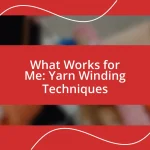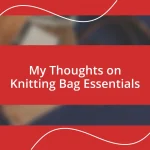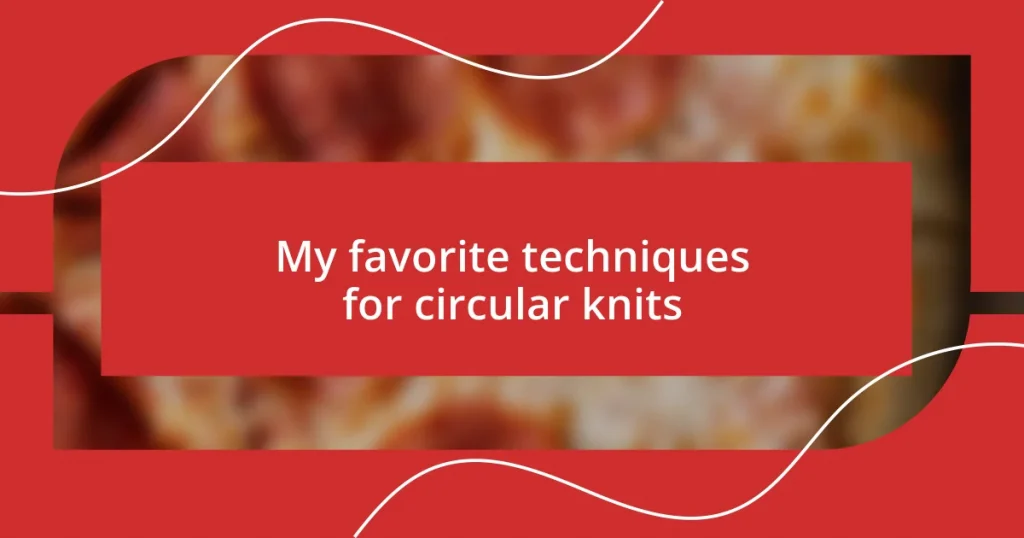Key takeaways:
- Circular knitting techniques, such as using circular needles and the magic loop method, enhance comfort and efficiency, allowing for seamless project creation.
- Choosing the right yarn type and weight is crucial for the desired outcome, with options like natural fibers, blends, and various weights impacting the project’s texture and warmth.
- Mastering cast-on methods and avoiding common mistakes, such as twisting stitches and ignoring gauge, are essential for achieving polished, professional finishes in circular knitting projects.

Understanding circular knitting techniques
Circular knitting techniques open up a world of creative possibilities. I still remember the first time I joined my stitches to form that perfect circle; it felt like unlocking a secret door to a whole new realm of knitting. Have you ever experienced that thrill, knowing you’re about to create something seamless and beautiful?
One popular technique is the use of circular needles, which have flexible cables that allow for easy handling of projects, especially larger ones. I find that switching from straight needles to circular ones made a world of difference in my comfort level and speed. It’s like discovering the magic of less strain on my wrists!
Another technique I enjoy is magic loop, especially for smaller circumference projects. Using this method, I can knit socks or sleeves without needing to buy numerous DPNs (double-pointed needles). Have you tried it? The first time I attempted magic loop, I was hesitant, but now it feels like second nature!
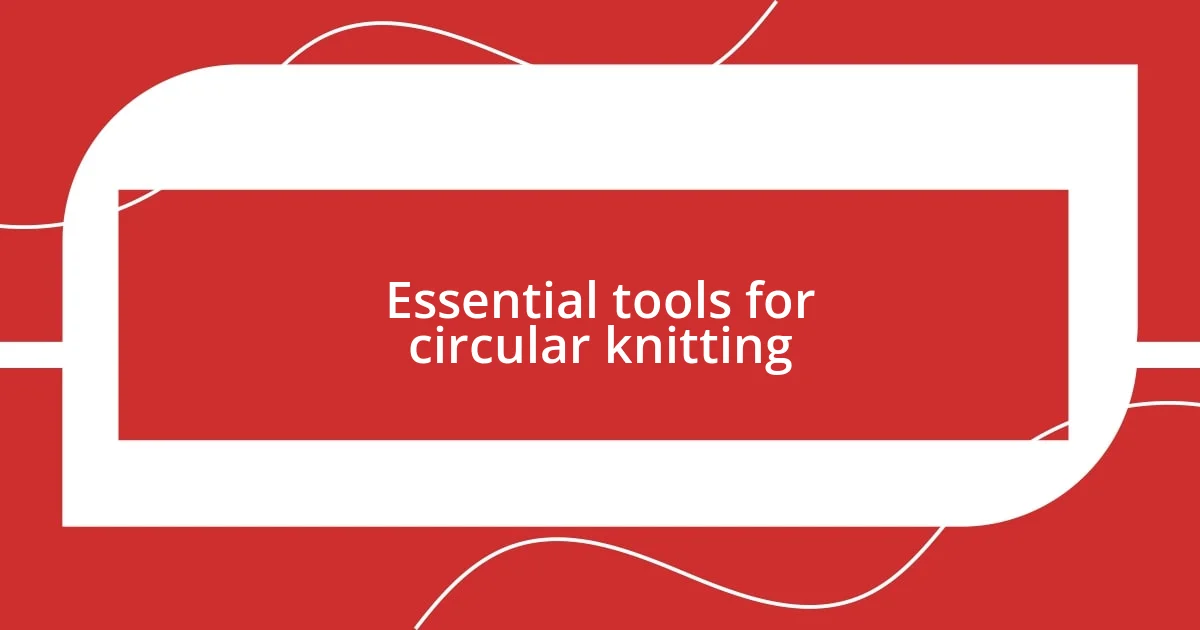
Essential tools for circular knitting
When it comes to circular knitting, having the right tools can elevate your experience. My favorite tool, without a doubt, is a set of quality circular needles. I remember my first pair – the smoothness of the tips and the flexible cable felt like magic in my hands. I found that investing time into selecting the right needle size and cable length truly impacts how the project flows, making everything more enjoyable.
Here’s a quick list of essential tools I’ve found indispensable for circular knitting:
- Circular Needles: Available in various materials like bamboo, metal, or plastic. Each offers a different feel and grip.
- Stitch Markers: These help track pattern repeats and indicate the beginning of rows.
- Tape Measure: Always handy for checking gauge and ensuring proper sizing.
- Yarn Needle: Also known as a tapestry needle for weaving in ends.
- Row Counter: Keeps track of your progress, especially for larger projects.
- Scissors: For snipping yarn neatly when you need to change colors or finish off.
Every time I reach for these tools, I feel a sense of excitement, knowing I’m equipped to bring my creative visions to life.

Choosing the right yarn types
When selecting yarn for circular knitting, I’ve learned that the type can dramatically influence your project’s outcome. For instance, natural fibers like wool and cotton provide unique textures and warmth, but that choice often depends on the final piece’s purpose. I remember knitting a summer tank top in cotton and finding it lightweight and breathable, perfect for those warmer days.
Choosing yarn also hinges on weight. Lighter weights such as lace or sport work beautifully for delicate projects like shawls, while heavier weights like worsted or bulky are ideal for cozy sweaters. I once attempted a bulky scarf that flew off my needles—it was instantly gratifying and so snuggly! Finding the right balance for your project is essential.
Lastly, don’t overlook yarn blends. Merino wool mixed with acrylic can give you the best of both worlds: superior softness with added durability. I’ve crafted many hats using these blends, and the variety of colors and textures has been a wonderful playground for my creativity.
| Yarn Type | Best Uses |
|---|---|
| Natural Fibers (e.g., Wool, Cotton) | Warmth and breathability for various seasons |
| Weight Options (e.g., Sport, Worsted) | Delicate items vs. cozy, heavier garments |
| Blends (e.g., Merino/Acrylic) | Softness with enhanced durability |

Mastering the cast-on methods
Mastering the cast-on methods can significantly influence your overall knitting experience. When I first dived into circular knitting, I was overwhelmed by the variety of cast-on techniques available. I vividly remember the moment I tried the long-tail cast-on for the first time; it felt like unlocking a new level of creativity. I loved how straightforward it was, yet I still enjoyed the challenge of mastering the tension.
One of my favorites is the Turkish cast-on, especially for projects starting out with a closed or seamless edge. The excitement of pulling the yarn at the right moment to reveal that perfect circle is truly gratifying. Have you ever felt the thrill of completing a technique that instantly elevates your project? I can relate, as that moment propelled me into trying more complex patterns.
Experimenting with different cast-on methods allowed me to find the best fit for each project. For instance, the two-color method was a game-changer when I made my first pair of colorwork mittens. The visual appeal and the smooth flow of stitches made it feel like I was painting with yarn. I encourage you to explore these methods; there’s a unique satisfaction in discovering the perfect cast-on for your own creations.

Techniques for seamless circular knitting
Seamless circular knitting is all about the techniques that help create a beautiful and polished finish. One method that I swear by is the magic loop technique. I recall my first experience trying to knit a pair of socks using this approach—it felt like I was mastering a hidden secret. Imagine effortlessly maneuvering long stretches of yarn while achieving a seamless result; the satisfaction was undeniable and prompted me to explore circular knitting even further.
Another technique worth mentioning is the use of a seamless join. When I first attempted to join my rounds without creating an unsightly seam, I remember feeling a mix of excitement and anxiety. But once I got the hang of it, I was amazed at how smooth my knitted pieces looked, especially when making hats with no visible seam lines. Have you ever had that moment of realization when you see your work transform in front of your eyes? It’s in those moments that I truly appreciate the art of knitting.
Lastly, incorporating short rows into your circular knitting can add delightful shaping while maintaining that seamless finish. I was hesitant to try this at first, fearing a complicated learning curve, but I was pleasantly surprised by how intuitive it felt. The first time I used short rows to shape a neckline, I was amazed at how the fabric hugged the contours so perfectly. Have you tried this technique yet? If not, I highly encourage you to give it a shot! The possibilities it opens up in your projects are just too enticing to ignore.
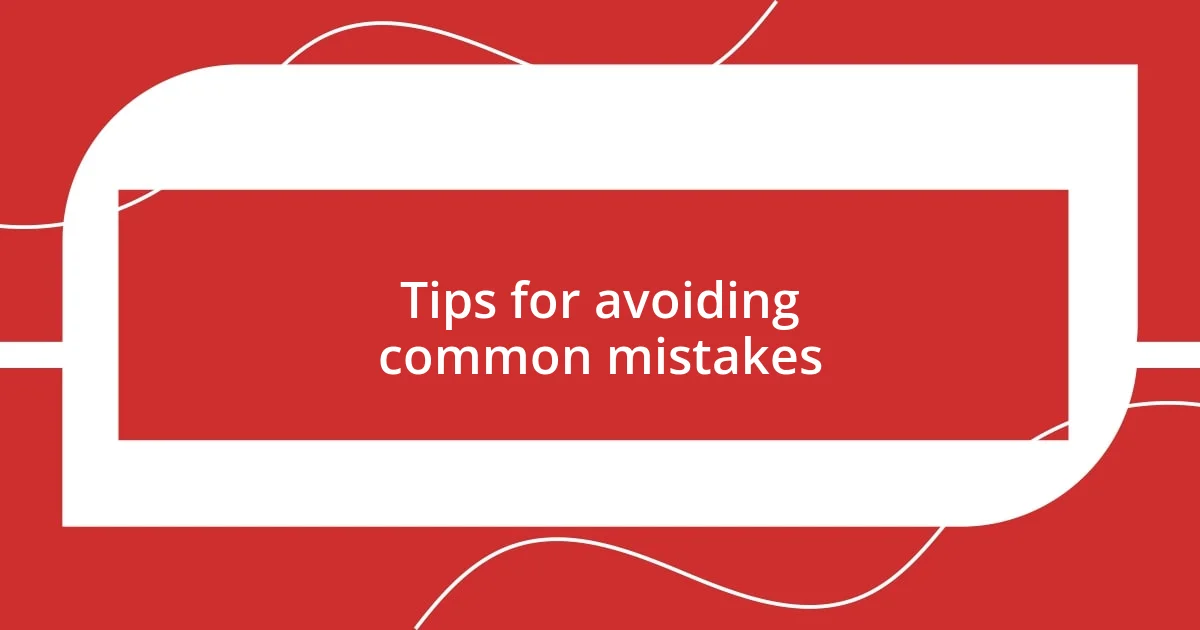
Tips for avoiding common mistakes
When knitting in the round, one common mistake is twisting your stitches during the join. I’ll never forget the confusion when I first realized my entire row was askew after just a few rounds. To avoid this, always lay your work flat and ensure that the stitches are oriented correctly before joining. Trust me, taking that moment to double-check can save you a lot of unraveling later.
Another pitfall is not being mindful of gauge, which can completely alter your project’s fit. I remember knitting a beautiful sweater with a yarn I loved, only to end up with a garment way too small. Now, I make it a habit to knit a swatch and measure my gauge before diving into a circular project. It may seem tedious, but the peace of mind it brings is worth every minute spent.
Lastly, pay attention to your yarn tension, especially when transitioning between different colorwork techniques. I made the mistake of knitting too tightly on one section, leading to an uneven fabric that frustrated me throughout the entire project. If you notice your tension changing, take a moment to relax your grip and adjust accordingly. It’s amazing how a small tweak can lead to such satisfying results. Have you ever felt the difference just by easing up a bit? It’s like a breath of fresh air for your knitting!
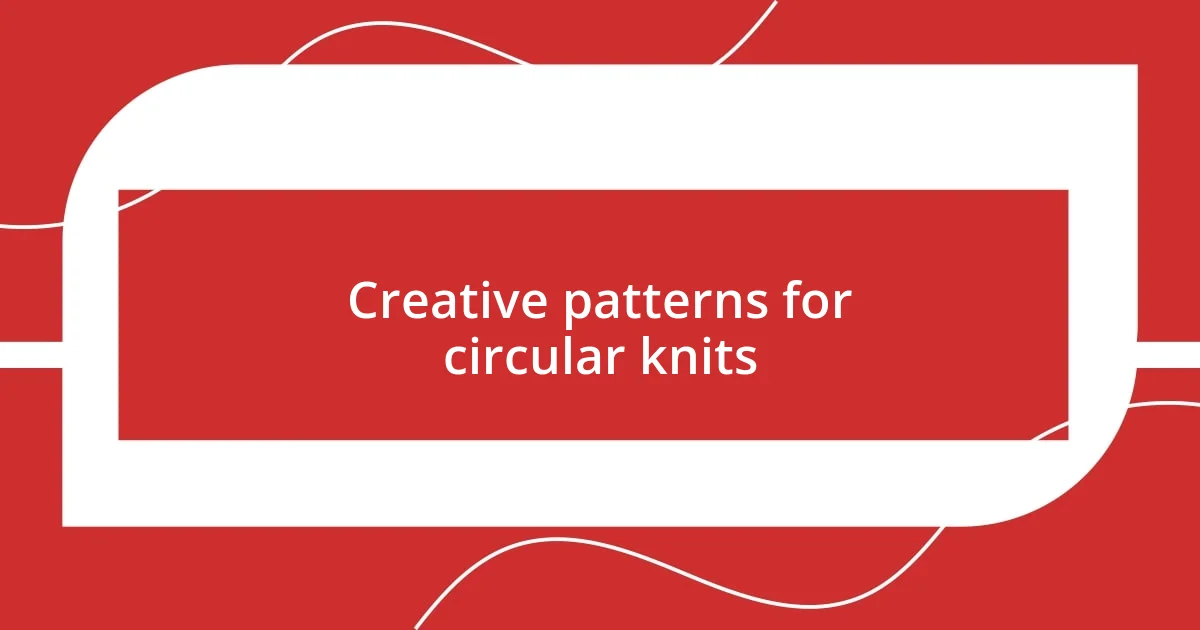
Creative patterns for circular knits
Creating unique patterns for circular knits is akin to painting on a blank canvas; it allows for limitless creativity. One of my favorite techniques is color pooling, which involves manipulating the yarn to create a stunning marbled effect throughout the project. I remember the thrill in my chest the first time I achieved this with a multicolored yarn; the fabric transformed with each stitch, and it felt like I was unveiling a masterpiece with every round.
Beyond color, texture can also play a pivotal role in your designs. Integrating different stitch patterns—like lace or cable work—into a circular knit not only adds complexity but also depth. I recall how excited I was the first time I introduced a cable pattern to a simple beanie. It was so rewarding to see how a few twists and turns elevated a basic design into something eye-catching. Have you ever experienced that sense of accomplishment when a simple technique turns your project into something extraordinary?
Lastly, mixing techniques keeps your knitting fresh and exciting. I once decided to combine intarsia with circular knitting for a pillow cover, and although it was a challenge, it pushed my skills to new heights. I learned an invaluable lesson about patience and planning—following a chart while maintaining the integrity of my rounds was no simple task! Have you tried combining techniques in your projects? When you do, you might discover a new love for circular knitting that you didn’t know existed.


